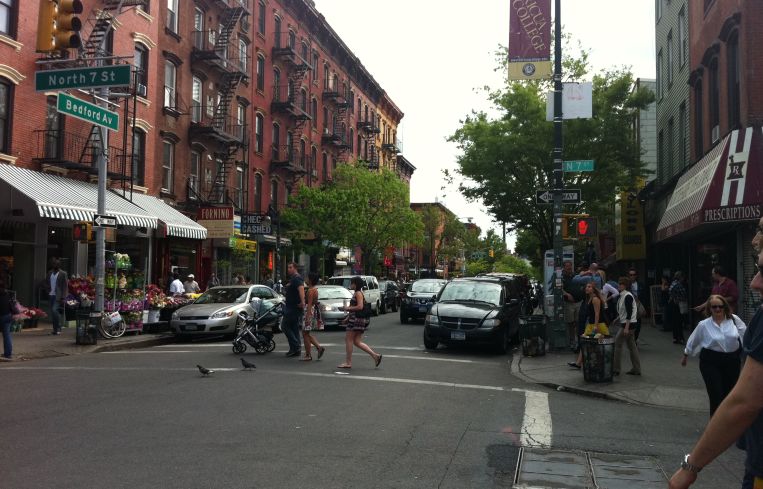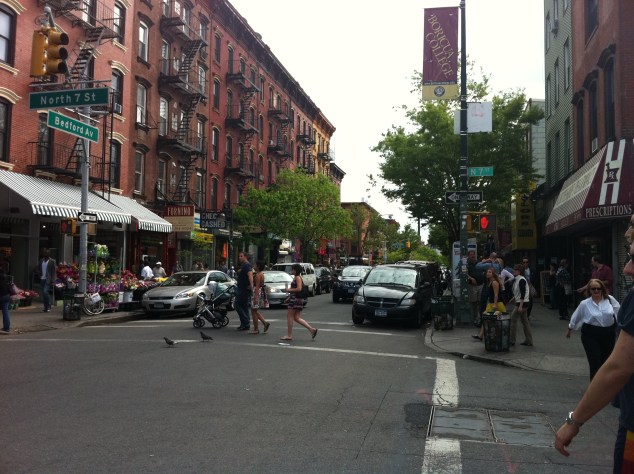For Retailers, a Kings County Presence Can Now Trump a Manhattan Debut
By Lauren Elkies Schram June 4, 2014 12:00 pm
reprints

National and international retailers until recently may have been commitment-phobes when it came to opening stores in Brooklyn, but that fear has been nearly quelled as mainstream chains like Whole Foods, J.Crew and H&M establish presences in the borough. And now that the big boys of retail are joining creative entrepreneurs, international and national brands have grown increasingly comfortable bypassing Manhattan and breaking into the New York City market via Brooklyn, especially Williamsburg.
Take the London-based record store Rough Trade, which since November has sold albums, served food and drinks and hosted concerts and exhibitions to crowds at Rough Trade NYC, at 64 North Ninth Street in Williamsburg. And then there’s European luxury kitchen goods company Cucina & Tavola, which recently opened its first New York City store at Williamsburg’s 235 Grand Street. In addition, Urban Outfitters’ concept store, Space Ninety 8, debuted in April at 98 North Sixth Street in the same neighborhood.
These retailers have come to realize what developers and residents have long known: Brooklyn has come into its own. And there are myriad reasons why. It’s easier to gain a foothold in Brooklyn compared to Manhattan thanks to more large spaces and—for now—relatively cheap rents. Kings Country landlords are generally more willing to take risks on untested tenants. And the customer base is more forgiving toward players in a less-crowded field.
“For a new start-up retailer to break into the Manhattan market is tough,” due to the price and competition, said Nicholas Griffin, a commercial broker with aptsandlofts.com. “You can in Brooklyn potentially get a location that has a decent amount of visibility and foot traffic for a decent price.”
To wit, the trendy Swiss watchmaker What is opening its first New York City store at 106 North Sixth Street in Williamsburg in October. As the American flagship concept store, What will debut its first line of design-forward, mono-function watches.
“In recent years, Brooklyn has emerged as the center of artistic and creative culture, recognized nationally and worldwide as a hotbed of trendiness and forward thinking,” said Sami Salmenkivi, the marketing director for What. “This is the exact audience that we are trying to reach—bold, unique and curious. After choosing to be in Brooklyn, Williamsburg was one of the places … that makes sense from a cultural and economic perspective.”
|
“In recent years, Brooklyn has emerged as the center of artistic and creative culture, recognized nationally and worldwide as a hotbed of trendiness and forward thinking.” |
Garry Steinberg, a managing director and partner at Lee & Associates who represented What, said he has another client, Lorna Jane, from Australia, that is checking out space in Brooklyn for its New York City debut. The company has hundreds of stores in Australia and nearly 30 in the United States.
“You have international interest in Williamsburg,” Mr. Steinberg said. “Every big retailer is trying to at least get information about the neighborhood. They know they belong there. They just want to know how and why they fit in.”
Peter Ripka, a co-founder of Ripco Real Estate, compared the interest in Brooklyn to the early retail boom days of Soho and the Meatpacking District.
“You’ve got the cool and the wow factor before the rents went crazy, and you appeal to the influencer,” he said. “Those influencers are living in Brooklyn now.” He added that it will become even more “common for retailers to open up in Brooklyn, especially in Downtown Brooklyn, rather than Manhattan.”
Some real estate professionals said Brooklyn is an important place in which to open a store but only as part of a larger rollout.
Jack Terzi, the chief executive of JTRE, represented Las Vegas-based Sugar Factory in a recent lease deal at Barclays Center, as Commercial Observer was the first to report last week. It was the second New York location for the café and sweets chain, and Mr. Terzi hopes to open another five to seven locations here.
“If you do a multiple rollout, Brooklyn is one location,” Mr. Terzi said. “It’s definitely hot, but it’s not the city.” He explained the appeal of the borough: “People are going to Brooklyn, because the rents are cheaper, not because they think they’re going to do better there.”
On the high end for the borough, retail rents on Bedford Avenue, Williamsburg’s main drag, are pushing beyond $200 per square foot and causing a ripple effect throughout the neighborhood where rents once in the $30 to $40 range are now reaching the $125 to $150 range, according to Geoff Bailey of SCG Retail. Meanwhile, in the top-tier corridor in Manhattan, from 49th to 59th Streets on Fifth Avenue, asking rents were $3,550 per square foot, according to a spring retail report from the Real Estate Board of New York.
Faith Hope Consolo, a retail broker with Douglas Elliman, said the trend of tenants starting with a Brooklyn location before one in Manhattan is in its infancy.
“Mostly, designers are going to Manhattan first, then crossing the river,” Ms. Consolo said. Instead of there being an influx of retailers establishing themselves in New York City by way of Brooklyn, Ms. Consolo anticipates “the boutiques in Brooklyn go on to become bigger names and open stores in Manhattan—think Otte. Bell and Bird, a Texas-based jewelry [company], popped up at [the boutique] Mociun in Williamsburg—a great intro to New York City.”
That appears to be happening already as places like Williamsburg-based Sweet Chick, OddFellow Ice Cream and Barcade open up shop in Manhattan.
Attorney Ian Lester of Bleckner P.C. represented Brooklyn Bowl in its 2009 Williamsburg and recent Las Vegas leases. The entertainment venue has also opened in a space in London.
“I think that the reason the client was approached to do Vegas and London was the idea of Brooklyn being an international commodity that landlords want to tap into,” Mr. Lester said.
He said that most of the contemporary fashion brands are mulling Williamsburg as they consider Manhattan.

Perhaps a couple of indicators of the increased importance of the Brooklyn market are that domestic and international tenants are willing to pay prices comparable to Manhattan’s. Also, as Mr. Lester pointed out, the quality of representation in deals has improved as tenants realize they need legal representatives with market specific know-how to get deals done.
On the national-retailer front, having scrapped plans for an Upper West Side location, the Austin-founded Alamo Drafthouse Cinema chain will open its first New York City movie theater at City Point in Downtown Brooklyn.
“When Alamo was looking at New York City, they looked at Brooklyn in the same way that they looked at Manhattan—as an equivalent location,” said Paul Travis, a managing partner at Washington Square Partners, the developer of the 1.8-million-square-foot retail, office and residential development City Point. The retail and office components are due for completion in 2016. Target’s smaller and more urban-focused City Target will open its first New York City shop there as well.
Brooklyn still has a “cool factor” that is appealing to tenants even as it enters respectable adulthood.
Robin Abrams, an executive vice president with Lansco, ticked off a series of retailers that haven’t hit Manhattan yet that are eyeing the borough: a national fashion chain that wants to be on Court Street, home furnishing tenants that are interested in Williamsburg side streets and larger big-box national users that are searching Atlantic Avenue for space.
|
“All of this has great appeal for retailers, many of whom have been priced out of Manhattan or believe that many areas have become too competitive and too commercial.” |
Ms. Abrams worked on the deal to bring Neiman Marcus’ discount outlet, Last Call, to the Brooklyn Municipal Building at 210 Joralemon Street in Downtown Brooklyn.
“They chose that location due to its proximity to public transportation and the strong co-tenancy with Sephora, Equinox, Trader Joe’s and Barneys all in the immediate vicinity,” she said. “The perception is that there is more value, with lower rents for space on highly trafficked retail corridors catering to a broad demographic. An increasing number of professionals have moved out to Brooklyn from Manhattan, joining an already dense customer base in a borough that is grossly understored. All of this has great appeal for retailers, many of whom have been priced out of Manhattan or believe that many areas have become too competitive and too commercial.”
As a Bococa (at the intersection of Boerum Hill, Cobble Hill and Carroll Gardens) resident and owner of New York-based interior design firm dash design, David Ashen has been watching the gentrification of Brooklyn.
While he has not seen retailers opening in Brooklyn before going elsewhere in New York City, he said he is seeing international brands like Gant testing out ideas in Williamsburg.
“Brooklyn’s become a brand,” Mr. Ashen said.
The borough is sure to see continued growth. That said, the amount of available space, especially in choice corridors, is starting to dwindle.
“I think the national and international retailers will all end up with a Brooklyn presence, some will be before Manhattan, and some after,” Mr. Travis said. “In 10 years, every national retailer will be in Brooklyn.”



